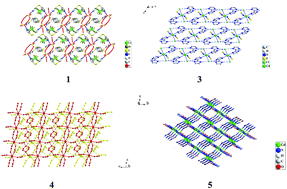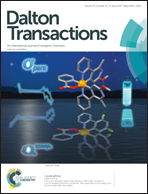New hybrid Cd(ii) compounds: synthesis and structural characterization†
Abstract
In an acidic solution, the room-temperature reactions of CdX2 (X− = Cl−, Br− or CH3COO−) and organic N-heterocyclic molecules with or without SCN−/SeCN−/dca− (dca− = dicyanamide) created the five new hybrid Cd(II) compounds [H2(4,4′-dtdpy)]2[CdBr4]SO4·2.5H2O (dtdpy = dithiodipyridine) 1, [H(2,2′-dtdpy)]2[CdBr4] 2, [(Hbim)2CdCl2(SCN)2] (bim = 2,2′-biimidazole) 3, [H2(pip)][Cd(SCN)4] (pip = piperazine) 4 and [CdL2] (L = HNC(OH)N−CN) 5. X-ray single-crystal diffraction analysis revealed that: (i) compound 1 is a double salt of [H2(4,4′-dtdpy)]SO4 and [H2(4,4′-dtdpy)][CdBr4], [H2(4,4′-dtdpy)]SO4 shows a two-dimensional (2D) supramolecular layer structure and [H2(4,4′-dtdpy)][CdBr4] is distributed in the space between the supramolecular layers; (ii) compounds 2 and 3 are mononuclear molecular entities. Of those, 2,2′-dtdpy and bim were only in situ monoprotonated; (iii) compound 4 contains a 2D supramolecular layered structure which is based on [Cd(SCN)4]2− chains


 Please wait while we load your content...
Please wait while we load your content...